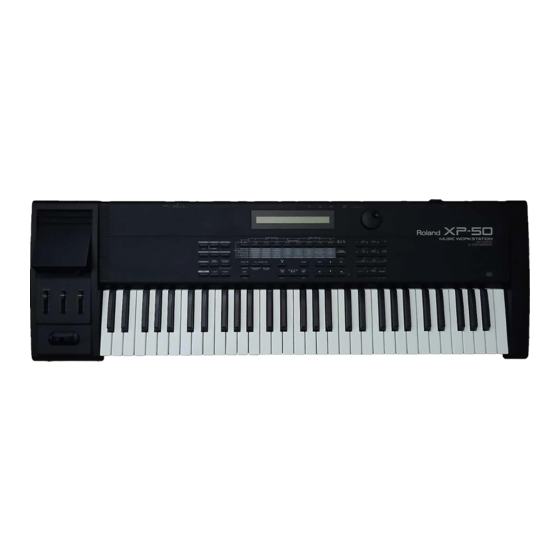
Roland XP-50 Supplemental Notes
Hide thumbs
Also See for XP-50:
- Owner's manual (187 pages) ,
- Service notes (28 pages) ,
- Quick start manual (186 pages)
Advertisement
®ÂØÒňÎ
August 27, 1997
Creating RPS Sequences from Standard MIDI Files on the XP-50
The Roland XP-50 Music Workstation is unique in its ability to follow your cues as the music director, keyboardist, live
performer – in real-time! Normally, when using MIDI files to accompany your performances, you have to decide
ahead of time: how many verses, how many choruses, how long the intro is, what order all these sections are in, etc.
Now, MIDI files can be as flexible as a live band with "RPS" – Real-time Phrase Sequencing on the XP-50. This
document will explain the procedure for converting an existing Standard MIDI File into an interactive RPS sequence.
Loading a Standard MIDI File into Memory
In order to create an interactive RPS sequence, you must first load the Standard MIDI File into the XP-50's internal
m
emory. Use the following procedure to load a Standard MIDI File:
1) Insert a disk that contains a Standard MIDI File into the XP-50 Music Workstation.
2) If the file was written for a General MIDI instrument, press the GM (PERFORM) button while holding SHIFT.
3) Press DISK/UTILITY.
4) Press "2" on the keypad to select LOAD.
5) Press "1" to select SONG.
6) Use the ALPHA DIAL to select the song you wish to load and press ENTER.
7) Press PLAY and listen to the whole song noting the measure numbers where various sections of the song
begin (i.e. intro, verse, chorus, etc). We will convert these sections into Patterns.
Creating Patterns
T he next step is to copy a range of measures into various Pattern locations on the XP-50.
1) Press EDIT so it is lit.
2) Press the TRACK EDIT (1/9) button (to the right of EDIT).
3) CURSOR to "Type" and use the ALPHA DIAL to select "03: COPY."
4) Press the CURSOR RIGHT ( 4 ) button twice to move the cursor to "Dest" (destination).
5) Use the ALPHA DIAL to select "PTN 001."
6) CURSOR to "Source" and use the ALPHA DIAL to select "ALL."
7) Press the CURSOR RIGHT ( 4 ) button to move the cursor to the "Measure" parameters.
8) Use the ALPHA DIAL and CURSOR LEFT and RIGHT ( 3 4 ) buttons to select the measures to be copied to
PTN 001. For example, the verse might start on measure 20 and last for 8 bars. The display for this example
would look like this:
NOTE: The measure where the copy will begin is indicated to the right of the arrow. In the example above, the
d
ata will be copied starting at the first measure of Pattern 001.
9) CURSOR to "Channel" and use the ALPHA DIAL to select "ALL."
10) Once you have finished setting the copy parameters, press ENTER. "Executing" will be displayed.
11) Repeat steps 2-8 to create more Patterns from any range of measures in the song. Remember to select a new
Pattern in step 5 each time you do this.
NOTE: Be aware that the first few measures of many Standard MIDI Files contains only setup data for that song
and the note data does not always begin on the first measure. If this is the case, it is advisable that this setup
data be assigned to a separate RPS Pattern and played back before any other Patterns to ensure that the
proper sounds are selected.
©1997 Roland Corporation U.S.
XP-50
®
Music workstation
Measure
20 for 8 → 1
Creating RPS Sequences from Standard MIDI Files
Supplemental
Notes
Page 1 of 2
Advertisement
Table of Contents

Subscribe to Our Youtube Channel
Summary of Contents for Roland XP-50
- Page 1 Now, MIDI files can be as flexible as a live band with “RPS” – Real-time Phrase Sequencing on the XP-50. This document will explain the procedure for converting an existing Standard MIDI File into an interactive RPS sequence.
- Page 2 This will help prevent timing glitches if you happen to trigger a Pattern too early or late. It is a good idea to erase any existing song data from the XP-50’s internal sequencer. This will allow us to play the sequencer for tempo purposes while preventing any unwanted song data from playing back with the RPS Patterns.
















Need help?
Do you have a question about the XP-50 and is the answer not in the manual?
Questions and answers